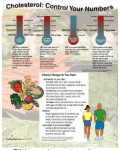The Perfect Storm for Heart Disease
 Excessive dietary intake of salt, saturated fat and cholesterol, coupled with a low intake of foods high in potassium and fiber, lead most people to develop high blood pressure and high blood levels of LDL-cholesterol. A typical modern Western diet promotes atherosclerosis and leads to coronary artery disease, which in turn leads to sudden cardiac deaths or fatal heart attacks. By contrast, a diet with lots of whole fruits and vegetables, mostly whole grains, and some nonfat dairy products (and seafood rich in omega-3s), with little added salt can prevent or even reverse the build-up of atherosclerotic plaques that lead to most fatal heart attacks, which are the #1 cause of death in both men and women in the United States. Throw in a few more cardiovascular disease risk factors like smoking, inactivity, and being overweight/obese (especially if accompanied by type 2 diabetes and increasing age) and you create the “perfect storm” for suddenly dropping dead of a heart attack.
Excessive dietary intake of salt, saturated fat and cholesterol, coupled with a low intake of foods high in potassium and fiber, lead most people to develop high blood pressure and high blood levels of LDL-cholesterol. A typical modern Western diet promotes atherosclerosis and leads to coronary artery disease, which in turn leads to sudden cardiac deaths or fatal heart attacks. By contrast, a diet with lots of whole fruits and vegetables, mostly whole grains, and some nonfat dairy products (and seafood rich in omega-3s), with little added salt can prevent or even reverse the build-up of atherosclerotic plaques that lead to most fatal heart attacks, which are the #1 cause of death in both men and women in the United States. Throw in a few more cardiovascular disease risk factors like smoking, inactivity, and being overweight/obese (especially if accompanied by type 2 diabetes and increasing age) and you create the “perfect storm” for suddenly dropping dead of a heart attack.
Creating the Perfect Storm
Two recent large, long-term epidemiologic studies add to the growing data linking diet to increased risk of cardiovascular disease morbidity and mortality. The first study followed over 12,000 US adults for an average of 14.8 years. During the follow-up period, there were 2,270 deaths, 825 of which were from cardiovascular disease. Over half (443) of those were from coronary artery disease. Both an increased salt intake and a lower potassium intake were associated independently with increased total mortality and cardiovascular disease deaths. However, the ratio of sodium to potassium in their diets was associated with the biggest increase in total and cardiovascular disease mortality (1). The study’s lead author, Elena Kuklina, is quoted in a NY Times article (dated 1/26/2011), saying, “We controlled for all major cardiovascular disease risk factors and still found an association between the sodium-potassium ratio and deaths from heart disease.” The sodium-potassium ratio goes up when highly processed foods loaded with refined carbohydrates and meats and cheeses displace fruits, vegetables, and whole grains in the diet.The second study followed over 80,000 middle-aged nurses for an average of 26 years and looked at the association between various lifestyle factors and their risk of sudden cardiac death. Most sudden cardiac deaths are due to heart attacks. Lifestyle factors were assessed with questionnaires every 2-4 years. Diet was assessed via a food frequency questionnaire every 2-4 years. A diet low in fatty animal products and refined carbohydrates and higher in whole grains, fruits, vegetables, beans, and fish was viewed as low-risk. Researchers plowed through reams of data looking for factors that were associated with an increased risk of sudden cardiac death in these women. They identified four risk factors, which, when combined, dramatically increased the women's risk of sudden cardiac death. These 4 risk factors included a high-risk diet, inactivity, being overweight, and smoking. Those who had none of those risk factors cut their risk of dying suddenly from heart disease by 92% compared to those who smoked, were overweight, didn’t get regular exercise, and ate a typical high-fat, low-fiber diet (2).
The Shocking Truth
While men tend to die sooner (on average) from heart disease than women, more women die of heart attacks each year than men. Part of the reason for this is that women are less likely to be diagnosed with advanced coronary heart disease than men, and so are less likely to have their MDs focus on cardiovascular disease risk factors that can be reduced with drugs and/or lifestyle changes. Primary prevention of heart disease is, in some ways, even more important for women than men because women are less likely to survive a first heart attack. Risk factors for cardiovascular disease increase significantly as women move through menopause. Diet-related risk factors such as hypertension, high cholesterol, obesity, and type 2 diabetes all worsen -- sometimes dramatically -- during and after menopause. Another problem is women are only half as likely as men to develop symptoms of severe heart disease before suffering a sudden, fatal heart attack, which makes it less likely that they know that they are running into trouble. Even worse, women are 66% less likely than men to have been diagnosed by their physicians with advanced coronary artery disease before suffering a sudden fatal cardiac event. The sad truth is that a healthier diet and lifestyle could eliminate over 90% of the deaths and disabilities now being caused by cardiovascular disease. The same healthful diet and lifestyle factors that could dramatically cut heart disease in women and men would also significantly reduce the risk of many types of cancer, stroke, Alzheimer’s disease, osteoporotic fractures, and numerous other ills. Diet and lifestyle really do matter.By James J. Kenney, PhD, FACN
References
- Yang Q, et al. Arch Intern Med. 2011;171:1183-91
- Chuive SE, et al. JAMA 2011;306:62-9
Brought to you by: TheNutritionEducationStore.com. Check out posters, PowerPoint Shows, games, and handouts that all discuss health, diet, exercise, the link between the three, and much more!


